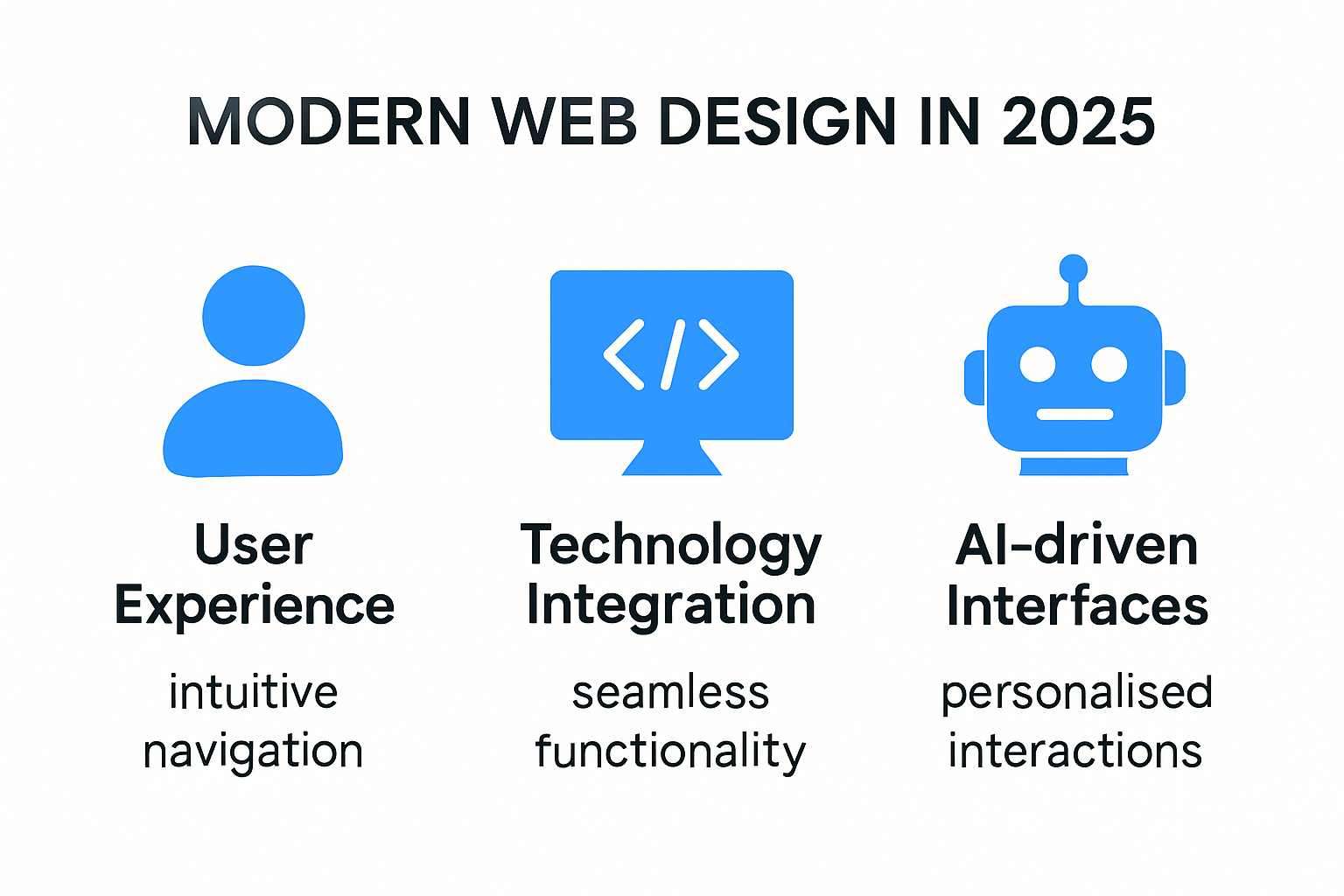Modern web design is moving fast, with brands now racing to meet user expectations across every device and touchpoint. You might think that flashy graphics or wild layouts are what makes a site stand out. But the real winners are the ones focusing on smart user experiences. Websites that put user-centric design first have been shown to boost engagement and conversions by over 30 percent, according to Google’s research. That is where the real impact lies, changing not just how sites look but how they work for every person who clicks.
Table of Contents
- Core Modern Web Design Elements In 2025
- Enhancing User Experience Through Design
- Brand Identity And Visual Communication Online
- Future Trends And Scalable Solutions For Growth
Quick Summary
| Takeaway | Explanation |
|---|---|
| User-Centric Design is Essential | Prioritising user experience through personalisation, accessibility, and predictive interactions enhances engagement and conversion rates significantly. |
| Integrate Technology Thoughtfully | Utilising adaptive interfaces, microinteractions, and AI-driven design enhances user journeys and fosters a seamless experience across digital platforms. |
| Effective Visual Communication | Brands must develop strategic visual storytelling and maintain digital consistency while being adaptable to create authentic connections with audiences. |
| Embrace Cloud-Native Architectures | Transitioning to cloud-native and microservices architectures enables greater flexibility, rapid deployment, and resilience in technological systems. |
| Focus on Predictive Scalability | Implementing predictive technologies and automated infrastructure management can anticipate business needs, thereby facilitating proactive system evolution. |
Core Modern Web Design Elements in 2025

Web design is transforming at an unprecedented pace, with technology driving radical shifts in how businesses communicate and engage online. Understanding the core modern web design elements for 2025 is not just about aesthetics but about creating digital experiences that are intelligent, responsive, and strategically aligned with business objectives.
User Experience (UX) as the Central Design Philosophy
Modern web design revolves around user-centric experiences that go far beyond traditional interface layouts. Google’s Web Vitals research demonstrates that websites prioritising seamless, intuitive interactions achieve significantly higher user engagement and conversion rates. This means designing with deep empathy for user journeys, anticipating needs before users explicitly express them.
Key UX considerations for 2025 include:
- Personalisation that adapts real-time content based on user behaviour
- Accessibility ensuring digital experiences work for users with diverse abilities
- Predictive interactions that streamline user pathways through intelligent design
Technological Integration and Adaptive Interfaces
The modern web design landscape is increasingly about creating adaptive ecosystems rather than static pages. Gartner’s Digital Experience Platforms report highlights that businesses must move beyond traditional web frameworks towards more dynamic, interconnected digital solutions.
Technological integration means:
- Seamless compatibility across devices and screen sizes
- Microinteractions that provide instant visual feedback
- Performance optimisation that ensures lightning-fast loading times
AI-Driven Design and Intelligent Interfaces
Artificial intelligence is revolutionising web design by enabling more nuanced, context-aware digital experiences. Designers are no longer just creating visual layouts but constructing intelligent systems that learn, adapt, and respond.
AI integration in web design encompasses:
- Automated layout adjustments based on user preferences
- Intelligent chatbots providing contextual customer support
- Dynamic content personalisation using machine learning algorithms
The future of web design is not about technology for technology’s sake but creating meaningful, responsive digital environments that genuinely serve user needs while meeting business objectives. By understanding and implementing these core elements, businesses can develop web experiences that are not just visually appealing but strategically powerful.
Successful web design in 2025 requires a holistic approach that balances cutting-edge technology with genuine human-centred design principles. It’s about creating digital spaces that feel intuitive, responsive, and deeply connected to user expectations.
To help compare the three core web design approaches discussed in this section, here’s a summary table outlining their main focus areas and features:
| Approach | Main Focus | Key Features |
|---|---|---|
| User Experience (UX) | User-Centric Interactions | Personalisation, Accessibility, Predictive Interactions |
| Technological Integration | Adaptive Ecosystems | Device Compatibility, Microinteractions, Performance Optimisation |
| AI-Driven Design | Intelligent Adaptivity | Automated Layouts, Contextual Chatbots, Dynamic Content Personalisation |
Enhancing User Experience Through Design
User experience (UX) has become the cornerstone of digital design, transcending mere aesthetic considerations to become a critical strategic business tool. In 2025, successful digital experiences are defined by their ability to create seamless, intuitive, and emotionally resonant interactions that meet user needs with precision and empathy.
Psychological Design Principles
Understanding human psychology is fundamental to exceptional UX design. Nielsen Norman Group’s research reveals that users form impressions within milliseconds, making the first interaction crucial. Designers must strategically leverage cognitive psychology to create interfaces that feel natural and effortless.
Key psychological design strategies include:
- Cognitive load reduction by simplifying complex information architecture
- Visual hierarchy that guides user attention intuitively
- Emotional design that creates positive psychological connections
Accessibility and Inclusive Design

Inclusive design is no longer optional but a fundamental requirement for modern digital experiences. Web Accessibility Initiative guidelines emphasise creating digital environments that work for users with diverse abilities, recognising that accessibility enhances usability for everyone.
Comprehensive accessibility approaches involve:
- Adaptive interfaces that adjust to individual user needs
- Screen reader compatibility for users with visual impairments
- Keyboard navigation options for motor-impaired users
Personalisation and Contextual Experiences
Advanced personalisation transforms user experiences from generic interactions to tailored, contextually relevant journeys. Modern design recognises that each user is unique, requiring dynamic experiences that adapt in real-time.
Personalisation strategies encompass:
- Machine learning algorithms that predict user preferences
- Contextual content delivery based on user behaviour
- Adaptive interface elements that evolve with user interactions
Successful UX design in 2025 requires a holistic approach that combines technological sophistication with deep human understanding. It’s about creating digital experiences that feel intuitive, respectful, and genuinely supportive of user goals.
Businesses must recognise that exceptional user experience is not a luxury but a fundamental competitive advantage. By investing in thoughtful, psychologically informed design, organisations can create digital environments that not only meet user needs but anticipate and delight them.
The future of digital design lies in creating experiences that feel less like interfaces and more like intelligent, empathetic conversations between technology and human needs.
For quick reference, here is a checklist table summarising the key UX strategies and principles highlighted in this section:
| UX Strategy/Principle | Addressed in 2025 Design |
|---|---|
| Personalisation | Yes |
| Accessibility & Inclusive Design | Yes |
| Predictive Interactions | Yes |
| Cognitive Load Reduction | Yes |
| Visual Hierarchy | Yes |
| Emotional Design | Yes |
| Adaptive Interface Elements | Yes |
| Machine Learning-Driven Experiences | Yes |
Brand Identity and Visual Communication Online
In the digital ecosystem of 2025, brand identity transcends traditional logo and colour palette design. Visual communication has become a sophisticated strategic tool that communicates complex organisational narratives through nuanced digital experiences. Modern brands must craft compelling visual languages that resonate authentically across multiple digital platforms.
Strategic Visual Storytelling
Adobe’s Design Trends Report highlights that successful visual communication is now about creating immersive, emotionally intelligent narratives. Brands are no longer just selling products but constructing comprehensive visual ecosystems that communicate values, personality, and unique positioning.
Key strategic visual storytelling elements include:
- Emotional resonance through carefully curated visual metaphors
- Consistent brand personality across different digital touchpoints
- Narrative-driven visual design that connects with audience experiences
Digital Brand Consistency and Adaptability
Pantone Color Institute emphasises the importance of visual systems that maintain core brand identity while remaining flexible enough to adapt to emerging digital platforms. Modern visual communication requires a delicate balance between recognisability and innovation.
Brand consistency strategies encompass:
- Responsive design that maintains visual integrity across devices
- Modular visual systems allowing dynamic brand expression
- Adaptive colour and typography that communicate brand essence
Interactive Visual Experiences
Interactivity has transformed visual communication from passive observation to engaging dialogue. Brands now design visual experiences that invite user participation, creating deeper connections through dynamic, responsive visual languages.
Interactive visual communication approaches include:
- Micro-animations that provide subtle emotional feedback
- Generative design that adapts to user interactions
- Immersive visual narratives that encourage exploration
Successful digital brand identity in 2025 requires a holistic approach that sees visual communication as a sophisticated, multidimensional conversation. It’s about creating visual experiences that are not just seen but felt, understood, and remembered.
Businesses must recognise that their visual identity is a powerful strategic asset. By investing in thoughtful, intelligent visual communication, organisations can create digital presence that distinguishes them in an increasingly crowded digital marketplace.
The future of brand identity lies in creating visual languages that are intelligent, adaptive, and deeply connected to human experience – transforming passive observation into meaningful interaction.
Future Trends and Scalable Solutions for Growth
The digital landscape of 2025 demands more than traditional technological approaches businesses must develop adaptive, scalable solutions that anticipate future market dynamics and technological shifts. Understanding and implementing forward-thinking strategies becomes critical for sustainable digital growth.
Cloud-Native Architecture and Microservices
Gartner’s Cloud Strategy Research indicates that cloud-native architectures will dominate enterprise digital infrastructure. Businesses must transition from monolithic systems to modular, highly flexible technological ecosystems that enable rapid innovation and seamless scaling.
Key cloud-native strategy components include:
- Containerised infrastructure enabling rapid deployment
- Serverless computing that optimises resource allocation
- Decentralised architectural models promoting technological resilience
Predictive Technology and Strategic Scalability
McKinsey Digital Transformation Report emphasises that successful digital solutions must integrate predictive technologies that anticipate business needs before they emerge. Scalability is no longer about handling increased load but creating intelligent systems that evolve proactively.
Predictive scalability strategies encompass:
- Machine learning algorithms that forecast technological requirements
- Automated infrastructure management
- Dynamic resource allocation based on real-time computational demands
Integrated Digital Ecosystem Development
Modern businesses require comprehensive digital ecosystems that seamlessly integrate multiple technological platforms. This approach transcends traditional software development, focusing on creating interconnected, intelligent systems that communicate and adapt dynamically.
Ecosystem integration approaches include:
- API-first development strategies
- Cross-platform compatibility
- Intelligent data synchronisation mechanisms
Successful digital growth in 2025 requires a holistic approach that views technology not as isolated solutions but as interconnected, adaptive systems. Businesses must develop technological strategies that are simultaneously robust and flexible, capable of responding to unpredictable market shifts.
Strategic technological investment means understanding that scalability is not just about handling increased load but creating intelligent, adaptive digital infrastructures that can transform alongside business objectives.
The future belongs to organisations that can develop digital solutions which are not merely functional but fundamentally intelligent adaptive systems capable of anticipating and shaping technological landscapes.
Frequently Asked Questions
What are the key elements of modern web design in 2025?
Modern web design in 2025 focuses on user-centric design, technological integration, and AI-driven interfaces. Key elements include personalisation, accessibility, adaptive interfaces, and intelligent interactions that enhance user engagement.
How can businesses enhance user experience on their websites?
Businesses can enhance user experience by implementing personalised content, ensuring accessibility for all users, and utilising psychological design principles to create intuitive and emotionally resonant interactions.
Why is brand identity important in web design?
Brand identity in web design is crucial as it helps communicate values and establish authenticity across digital platforms. A strong visual narrative can create deeper connections with audiences, differentiating brands in a crowded marketplace.
What technological trends should businesses consider for future web design?
Businesses should consider transitioning to cloud-native architectures, leveraging predictive technologies for scalability, and developing integrated digital ecosystems to ensure their web solutions are adaptable to future market dynamics.
Transform Your Digital Presence with Future-Ready Design
The article shows that staying relevant in 2025 demands more than a good-looking website. Real business growth now depends on user-centric design, seamless experiences, and intelligent integration. If the thought of falling behind in technology or not meeting rising user expectations worries you, you are not alone. Many South African businesses struggle to deliver truly engaging digital journeys that turn visitors into loyal customers. The need for personalisation, adaptive interfaces, and innovative technology has never been greater.
Do you want your brand to stand out with web solutions that are ahead of the curve? Choose Cloudfusion for expert-crafted websites that prioritise modern web design elements like accessibility, AI-driven personalisation, and strategic storytelling. Our team brings world-class web development expertise and industry insights to every project, helping you exceed customer expectations. Act now and let us help your business move forward with smarter, more powerful digital experiences. Start by requesting your custom web design and development quote today.








